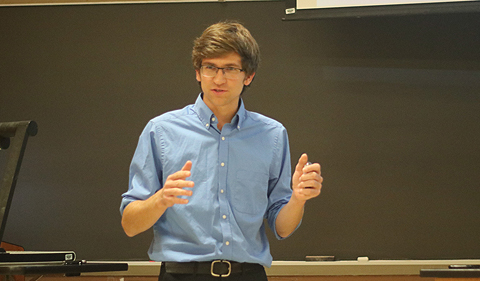By Matthew Connell
(B.S. Physics, B.S. Mathematics, Honors Tutorial College, Class of 2020)
I traveled to Germany last summer to participate in a summer internship at the Second Institute for Physics at Georg-August-Universitat Gottingen, where I worked with doctoral student Kira Abeling primarily, as well as with Dr. Stan Lai and Dr. Jason Veatch. The German Academic Exchange Service (also known as DAAD) and the German RISE program sponsored my internship.
I worked to analyze data for the ATLAS experiment at the Large Hadron Collider (LHC), which is operated by CERN in Geneva, Switzerland. In the Large Hadron Collider, physicists accelerate clusters of particles that then collide into each other at very high energies. These particles combine and create different particles, which can decay into yet more particles that out of the test chambers in the LHC. These high-energy collisions give us insight into the smallest and most fundamental particles that make up the universe. ATLAS is an experiment at the LHC; the most significant feature of which is a huge particle detector for determining the particles that come out of these particle collisions. Scientists discovered the now famous Higgs boson at the LHC in 2012, partially through ATLAS.
In Gottingen, I studied the properties of particles that come out of a particular reaction in a particle collider. I worked with simulated data, called “Truth Containers,” which held simulated particle collisions. The particular reaction I was looking at is one where two Higgs bosons are produced simultaneously, (or “diHiggs”,) and then those Higgs bosons eventually decay into their final state, a set of particles notated as bbVV. I studied the direction of motion, momentum, and energies that the particles would have throughout this experiment, through the simulations. I plotted these kinematic distributions in histograms to make the physics that is happening on this level more visible.
Searching for what particle reactions occur and how these reactions proceed at high energies is the best way we have now to study the fundamentals of the universe. If there are more particles produced in a certain distribution than we expect with standard physics, then we have some hint as to physics “beyond our Standard Model,” or BSM. The particles associated with my diHiggs decay are linked to BSM physics.
Showing what physics is happening in these reactions on the particle level help us to understand the diHiggs reaction. Some physicists working in analysis look at actual data that comes from the particle detectors at ATLAS. To do so they must make cuts to the huge amounts of data produced by ATLAS and use algorithms and tools to sort this data. My results will help them determine which tools fit the underlying particles’ motion and whether they are able to ignore unimportant data points. I helped provide a check that the other researchers were staying true to the physics underlying their analysis.
This topic is exciting to me because it is on the cutting edge of our understanding of the universe. The Standard Model of particle physics is our best theory describing known fundamental forces in the universe. However, I am interested in pushing beyond this model to BSM physics, and my work was on an aspect of this concept.
Read more about Matthew Connell’s summer internship experience Students complete international physics, biology research in Germany through DAAD RISE program.




















Comments